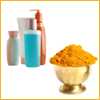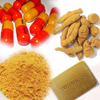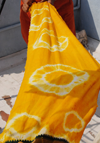Uses Other usesUses in folk medicines
Ayurvedic Uses:
 |
Besides flavoring food, to purify the blood and skin conditions remedy is probably the most common use of Turmeric in Ayurveda. Turmeric is everywhere in Ayurveda. This multi-faceted wonder spice helps detoxify the liver, balance cholesterol levels, fight allergies, stimulate digestion, boost immunity, enhance the complexion. |
Culinary Uses:
 |
It is impossible to think of Indian food without turmeric. When added to Indian delicacies such as Curry and Rice, it gives a rich color and slight flavor to food. Turmeric combines well with spices such as Chilli powder, Coriander powder, Cumin, and Cinnamon,etc. Ground Turmeric is used worldwide as a seasoning. |
Cosmetic Uses:
 |
Since ages, Turmeric is very popular in cosmetic use especially for women. The skin is the main portion of the body and provides a shielding barrier against harmful chemicals, microbes, and ultraviolet radiation. Natural plant products like turmeric have been formulated to heal and prevent dry skin, treat skin conditions such as eczema and acne, and retard the aging process. |
Curcumin from Turmeric also used in natural dye produces a range of colors from yellow to deep orange. Apart from sentimental value, Turmeric and Turmeric preparations like kumkum and parani serve Hindu women as an inexpensive and indigenous beauty aid in their bath. Smearing Turmeric paste on face and limbs during a bath is found to clear the skin and beautify face. Its antiseptic and healing properties are said to be both a preventive cures for that much feared malady of adolescence-pimples. It is also known to discourage unwanted hair on feminine skin.
Medicinal Uses:
 |
It is essential in the daily life, to heal many health disorders like liver problems, digestive disorders, treatment for skin diseases and wound healing. Turmeric has long been used in medicinal as an anti-inflammatory. Curcumin is the active ingredient in turmeric which has been shown to have a wide range of therapeutic effects. In the Indian system of medicine, turmeric occupies an |
important place, as an ingredient in the preparation of medicinal oils, ointments and poultice.It is a stomachic, carminative, tonic, blood purifier, vermicide and an antiseptic.It is also prescribed as an anti-periodic alternative.Boiled with warm milk and taken internally, or used as an inhalation from boiling water, eras smoke through pipe in combination with omum, it relieves sore throat and common cold.The juice of raw rhizomes is used as an anti-parasitic for many skin affections.In smallpox, it is applied as a paste with gingelly (sesame) oil and neem leaves.Burnt Turmeric used as tooth powder relieves dental troubles.The juice of Turmeric rhizomes is believed to relieve purulent ophthalmia.Turmeric is useful in treating gall stones and gall complaints.
Food Flavour & Colour:
 |
By far the largest quantity of Turmeric is utilized in most of the Asiatic countries as a food adjunct in vegetable, meat and fish preparations.It is used to flavour and at the same time to colour butter, cheese, margarine, pickles, mustard and other foodstuffs. It is also used to colour liquor, fruit drinks, cakes |
and table jellies. It is one of the principal ingredients of the curry powder, which is a blend of many spices, common salt and farinaceous matter.
As Dye:
 |
Earlier, in India, turmeric was largely used for dyeing wool, silk and cotton, to impart a yellow shade, in an acid batch. It is still used to dyeing cotton. The dye is also employed as coloring material in pharmacy, confectionery, rice milling and food industries. Considerable quantities of turmeric are converted as kumkum used for tilak.Its use as a colouring material is reported in the paints and varnishes industry also. Turmeric paper is an official reagent in British pharmacopoeia for testingalkalinity. A diluted, tincture of turmeric is suitable for |
use as a fluorescence indicator even in brown and yellow solutions.· Turmeric is an anti-oxidant, due to the phenolic character of curcumin.

• It is used to flavour and colour butter, cheese, margarine, pickles, mustard, liquor, fruit drinks, cakes, table jellies and other food stuff. It is one of the principal ingredients of curry powder, which is a blend of many spices, common salt and farinaceous matter.
• Provides a natural dye to colour cloth, leather, silk, palm fibre, wool and cotton.
• As a chemical indicator, it changes colour in alkaline and acid substrates. Turmeric paper, prepared by soaking unglazed white paper in the tincture and hen dried is used as a test for alkaloids and boric acid.
• Turmeric rhizomes yield 2-6% orange yellow essential oil (curcumin, upon oxidation becomes vanillin) used in flavouring spice products and in perfumery.
• Powdered turmeric is antioxidant.
• One fraction of oil of turmeric has antiarthritic and antiinflammatory activity in rats.
• Curcumin has antiedemic activity.
• The major quantity of turmeric is utilized as a condiment and only a small quantity is used in medicines and cosmetics in India.
• In many Asian countries, turmeric is used as a food adjunct in vegetables, meat and fish preparation.
• It also acts as an appetizer and aids in digestion.
• A pinch of turmeric powder is often added to most of our savouries to impart simultaneously an agreeable flavour, colour and to improve keeping quality.
• Turmeric oil and oleoresin are also used to impart the flavour in food and perfume industries.
• The antimicrobial properties of essential oil from turmeric are reported against pathogenic bacteria and fungi.
• The essential oil of turmeric is antiseptic and it is used in treating gall stones and gall complaints.
• Turmeric preparations are traditional beauty aids for India women. Smearing turmeric paste on face and limbs during a bath, clears the skin and beautifies the face.
• Its antiseptic and healing properties are said to be both preventive and cure for the much feared malady of adolescence pimples.
• Kum-kum popular with every housewife is also a by-product of turmeric. It finds a place in offerings on religious and ceremonial occasions.
• Indonesians used turmeric to dye their bodies as part of their wedding ritual.
• In recent years, turmeric powder was found to be effective against. Nuclear Polyhedrosis Virus causing grasserie disease in silkworm.

• Medicinally, turmeric is regarded as carminative, stomachic, a cure for liver troubles, taken internally for treating ulcers, or externally as an ointment to heal skin sores.
• Boiled with milk and sugar, it is used as a cold remedy.
• Orientals use the rhizome for jaundice
• In turmeric, antagonistic medicinal compounds such as curcumin increasing bile secretion and bis-desmethoxy curcumin decreasing it are recorded.
• Chinese consider the root alterative, antiparasitic, antiperiodic, cholagogue, depurative, haemostat, stomachic, tonic, and apply it externally for inflammation, indolent ulcers and purulent ophthalmia.
• They use turmeric for abdominal pain, bruises, chest pains, colic, coma, dysmenorrhea, epistaxis, fever, flatulence, hematuria, hematemesis, hepatitis, sores and tooth ache, and poultice in onto itch, ringworm and sores.
• They also employ turmeric for arsenic poisoning, hemoptysis, mania, post partum haemorrhage and primary syphilis.
• Ayurvedics use turmeric as alterative, antiperiodic, depurative, stomachic, tonic, perhaps reflecting the fact that the essential oil is antiseptic, antacid, apertif, stomachic and tonic in small doses and acting as antispasmodic in large doses.
• Ayurvedics also prescribe for boils, biliousness, bruises, dyspepsia, dysuria, elephantiasis, inflammations, leucoderma, scabies, smallpox, snakebite, and swellings.
• Yunanis prescribe for affections of the liver and jaundice, urinary discharges, scabies and bruises.
• A decoction of the rhizomes is applied to relieve catarrh and purulent ophthalmia.
• Indians apply roots to leech bites.
• Fumes of burning turmeric directed into the nostrils cause a copious mucous discharge and relieve the congestion.
• Turmeric is given in diarrhea, so troublesome and difficult to subdue in atonic subjects.
• It is employed in intermittent fevers and dropsy.
• The root, parched and powdered is given in bronchitis; the fumes are used during hysteric fits.
• A paste made of fresh rhizome is applied on the head in cases of vertigo.
• Turmeric and alum are blown into the ear in chronic otorrhea.
• The flowers, pasted, are used in ringworm, other parasitic skin diseases and gonorrhea.
• Cambodians consider the leaves anti-pyretic.
• In Madagascar, the rhizome is used as an aperient, astringent, carminative, cordial, detergent, diuretic, emmenagogue, maturant, stimulant and tonic.
• From the "food farmacy" for lymphoma, turmeric is an important source of curcumin and burdock, an important source of arctigenin and trachelogenin.
|












